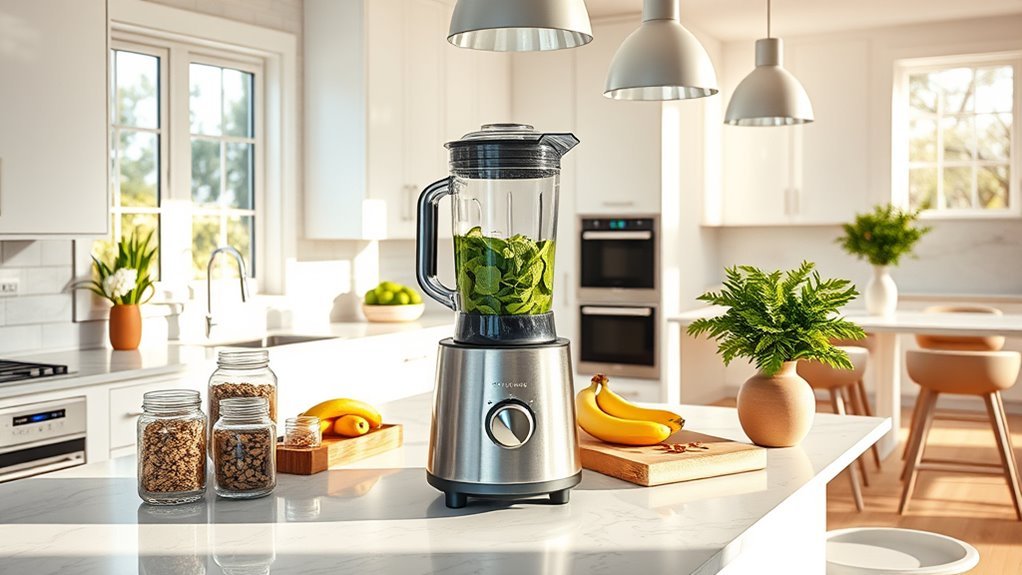We’ll be blunt: Vitamix blenders are loud, typically ranging from 64-98 decibels. The Quiet One leads at 64dB, while the A3500 tops home models at 84dB. Each 10dB increase means sound intensity multiplies tenfold – so yes, that’s significant. Factors like motor power, ingredients, and speed settings affect noise levels. A sound-dampening mat helps, but for serious noise reduction, you’ll want to explore our advanced soundproofing strategies.
Understanding Decibel Measurements in Blenders

Why should we care about decibel measurements when choosing a Vitamix? Let’s get real: noise levels matter, especially when you’re blending at 6 AM.
Decibel levels tell us exactly how loud our blender will be, with each 10 dB increase representing a tenfold jump in operating sound intensity.
Most Vitamix models aren’t winning any silence awards – they’re cranking out 70-90+ dB. That’s vacuum-cleaner-to-motorcycle territory.
But there’s hope: The Quiet One leads the pack at just 64 dB, while the A3500 stands as the quietest home model at 84 dB. High-performance blenders often come with various speed settings and preset programs, which can also influence noise levels during operation.
Understanding these differences is essential for environmental noise reduction, particularly if you’re blending in shared spaces.
When comparing Vitamix blenders, these measurements aren’t just numbers – they’re the difference between peaceful morning smoothies and angry neighbors.
Comparing Noise Levels Across Vitamix Models
Looking at specific noise levels reveals stark differences between Vitamix models – and we’re talking dramatic gaps here.
The Quiet One leads the pack at just 64 dB at maximum speed, while the A3500 follows at 84 dB – that’s the quietest non-commercial option you’ll find.
In the Legacy models lineup, the Pro 750 hits 88 dB, making it quieter than most but still louder than the A3500.
Want to really understand the difference in user experience? Consider the E310 and E320, which roar at up to 98 dB.
Here’s the kicker: each 10 dB increase means sound intensity multiplies tenfold.
The Quietest Vitamix Options Available

When it comes to finding a truly quiet Vitamix, you’ve got two standout choices – and they’re not even close to the competition.
The A3500, with its metal finish and sound-dampening features, operates at 84 dB, while the Pro 750 runs at 88 dB. Both offer impressive noise reduction compared to standard blenders.
- The A3500 claims the title of quietest non-commercial Vitamix, letting you maintain conversation with just a slightly raised voice.
- The Pro 750’s noise levels strike a balance between performance and quieter operation, though it’s marginally louder than the A3500.
- Both models incorporate advanced sound-dampening features, which explain their premium pricing. Additionally, these models exemplify the higher price range associated with high-performance blenders, reflecting their advanced technology and functionality.
We’ll be straight with you – if noise levels are your primary concern, the A3500’s superior sound-dampening technology makes it your best bet among Vitamix options.
Factors Affecting Blender Noise Output
Now that you know the quietest Vitamix options, let’s break down what actually causes all that noise.
Powerful motors drive these machines, with higher wattage typically meaning more decibels. But that’s not the whole story.
Sound-dampening features and container design make certain Vitamix models quieter options, like the A3500 at 84dB.
What you’re blending matters too – harder ingredients create more racket than soft ones.
We’re also looking at speed settings; faster speeds equal more noise.
Here’s a pro tip: Your operating surface plays a huge role. Hard countertops amplify sound reflection, so place your blender on a rubber mat.
It’s simple physics – softer surfaces absorb vibrations, keeping those noise levels in check.
Soundproofing Tips for Your Vitamix

Since your Vitamix’s noise levels can disrupt your entire household, let’s tackle some serious soundproofing solutions. The key to minimizing disturbance lies in smart placement and proper noise reduction techniques.
We’ve tested multiple approaches to help you blend without driving everyone crazy.
- Place your Vitamix on a sound-absorbing mat to reduce vibrations and echo from counter surfaces.
- Create a DIY soundproof box or designate a separate blending location away from common areas.
- Time your blending sessions during quieter times of day and use ear protection when needed.
These strategies work together to create a more peaceful blending environment.
Impact of Speed Settings on Noise Generation
Understanding your Vitamix’s speed settings directly impacts its noise output, with each speed level creating distinct acoustic signatures.
We’ve found that noise levels increase considerably at higher speeds, with models like the A3500 reaching 84 dB at maximum speed – one of the quieter options compared to the E310’s hefty 98 dB.
Here’s what you need to know: A 10 dB jump means sound intensity multiplies tenfold.
When blending dense ingredients or ice, higher speeds create notably more noise. We recommend starting with lower settings and implementing a gradual increase in speed.
It’s simple physics – the harder your Vitamix works, the louder it gets. Smart speed management doesn’t just protect your ears; it also guarantees ideal blending performance while maintaining reasonable noise levels.
Best Times to Use Your Vitamix Blender
Choosing the right time to fire up your Vitamix isn’t just about convenience – it’s about being a considerate blending ninja. We’ve found that off-peak hours provide the sweet spot for quieter blending, especially with the A3500 model’s 84 dB operation level.
- Early mornings and late evenings offer prime blending windows, perfect for meal prep and large batches without disturbing others.
- Weekend mid-mornings are ideal for shared spaces, when neighbors are typically out and about.
- Post-school-run times create a peaceful environment for those working from home.
In apartment living, timing is everything. We recommend syncing your blending schedule with your household’s natural quiet periods.
This strategic approach lets you maximize your Vitamix’s potential while minimizing disruptions to your living space.
Frequently Asked Questions
How Loud Should Vitamix Be?
We’d expect our Vitamix’s sound to range between 64-98 decibels, depending on the model. While professional units offer quieter operation through sound insulation, standard models are louder during blending but still within normal kitchen appliance range.
Which Is Quieter, Vitamix 750 or 7500?
We’ve analyzed the decibel measurements and customer feedback: the Vitamix 750 operates at 88 dB while the 7500 reaches 90 dB, making the 750 the quieter choice for noise-sensitive users.
What Is the Difference Between A2300 and 5200?
We’ll find the A2300 offers digital controls and SELF-DETECT technology, while the 5200 has simpler operation. Both share container size, but A2300’s quieter performance and modern features command higher pricing.
How Many Decibels Is Vitamix?
We’ll find most Vitamix blenders operate between 70-90 decibels, with The Quiet One hitting 64dB, the A3500 at 84dB, and standard models around 88dB during maximum blending speed.

